Olympus M.Zuiko ED 12-40mm f/2.8 PRO Lens Review
Olympus M.Zuiko ED 12-40mm f/2.8 PRO Performance
At 12mm sharpness is already outstanding across the frame, and there is only a slight improvement in clarity when stopped down one stop. This pattern is repeated at 18mm with excellent sharpness being achieved between maximum aperture and f/8.Zooming to 40mm results in a slight reduction in sharpness at maximum aperture, although performance is still very good in the centre of the frame and good towards the edges of the frame at f/2.8. Stopping down to between f/4 and f/5.6 results in outstanding sharpness across the frame at this focal length.
This lens appears to be particularly affected by diffraction at small aperture settings, with a dramatic reduction in sharpness being visible at f/22. Although this may not be an issue for many, those wishing to use small apertures for longer exposures, might want to use a neutral density filter instead so that the lens can be kept closer to its optimum aperture range.
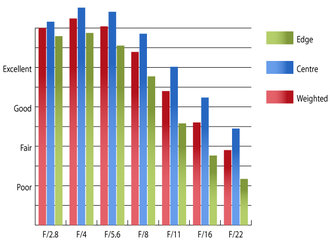 MTF@12mm | 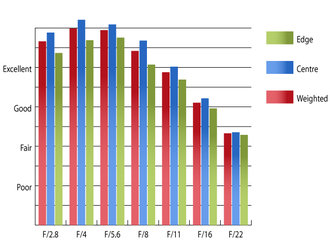 MTF@18mm |
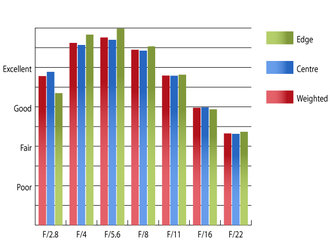 MTF@40mm | How to read our chartsThe blue column represents readings from the centre of the picture frame at the various apertures and the green is from the edges. Averaging them out gives the red weighted column.The scale on the left side is an indication of actual image resolution. The taller the column, the better the lens performance. Simple. For this review, the lens was tested on a Panasonic Lumix G6 using Imatest. |
Chromatic aberrations are well controlled throughout most of the zoom range. Between 12mm and 18mm fringing only exceeds half a pixel width when stopped down to between f/11 and f/22. At 40mm fringing just exceeds three quarters of a pixel width towards the edges of the frame at f/2.8, but even so, this low level should be difficult to spot.
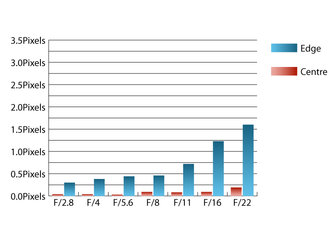 CA@12mm | 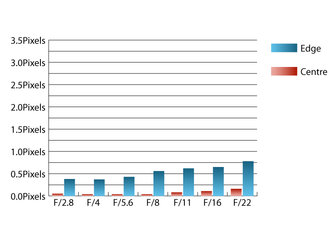 CA@18mm |
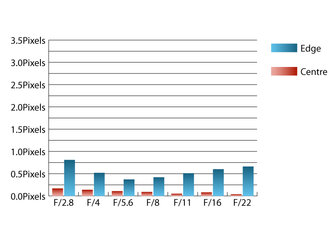 CA@40mm | How to read our chartsChromatic aberration is the lens' inability to focus on the sensor or film all colours of visible light at the same point. Severe chromatic aberration gives a noticeable fringing or a halo effect around sharp edges within the picture. It can be cured in software.Apochromatic lenses have special lens elements (aspheric, extra-low dispersion etc) to minimize the problem, hence they usually cost more. For this review, the lens was tested on a Panasonic Lumix G6 using Imatest. |
Falloff of illumination towards the corners is fairly typical for a standard zoom lens, and shouldn't pose too many issues. At 12mm and f/2.8 the comers are 1.35 stops darker than the centre of the image and at 40mm, and falloff is reduced and the corners are only 0.76 stops darker than the image centre. Stopping down to f/5.6 results in visually uniform illumination across the frame throughout the zoom range.
Distortion is well corrected in camera, but without corrections applied, Imatest detected 5.51% barrel distortion at 12mm being replaced with only 0.965% pincushion distortion at 40mm. The level of distortion at 12mm will be quite noticeable in images with lines parallel to the edge of the frame, although the distortion pattern is uniform across the frame throughout the zoom range, which should make applying corrections in image editing software afterwards, relatively straightforward.
A petal-shaped hood is supplied with this lens, which does a reasonable job of shading the lens from extraneous light that may cause issues with loss of contrast or flare. Even without the hood in place, this lens is very resistant to flare and contrast levels hold up well when shooting into the light.
Add your message
Login required
Please login here or if you've not registered, you can register here. Registering is safe, quick and free.
Please login here or if you've not registered, you can register here. Registering is safe, quick and free.
photodo Stats
1102 lenses
428 MTF tests
74 in-depth photodo reviews
100+ users join each day
Help the lens community by reviewing or rating a lens today via our lens search
428 MTF tests
74 in-depth photodo reviews
100+ users join each day
Help the lens community by reviewing or rating a lens today via our lens search
Latest Lens Reviews
- Chinon 28mm f/2.8 Vintage Lens Review
- Canon EF 70-200mm f/4L IS II USM Lens Review
- Samyang AF 85mm f/1.4 EF Review
- Sigma 70mm f/2.8 DG Macro Art Review
- Samyang AF 24mm f/2.8 FE Review
- Meike 50mm f/1.7 Review
- Tamron 70-210mm f/4 Di VC USD Review
- Lensbaby Burnside 35mm f/2.8 Review
- Asahi Super Takumar 50mm f/1.4 Review
- Asahi Super-Multi-Coated Takumar 135mm f/3.5 Review
